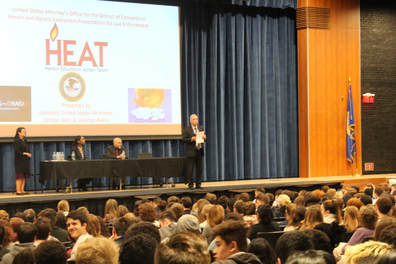|
By Bryce Cox  Wethersfield High School students attended a heroin and opioid awareness assembly during periods 1 and 3 on April 3, 2018. This assembly was made possible by HEAT (Heroin Education Action Team); guest speakers Carolyn Ikari and Vanessa Avery, assistant US attorneys, and Reverend Williams, father of Jesse Williams, a victim of an oxycodone overdose. Ikari first addressed the significance of opioid and heroin addictions. In 2017/2018, overdose was the top cause of accidental death, rocketing above the number of fatalities that were the result of car crashes, suicides, and homicides combined. Opioid and heroin substances are becoming more easily available due to exposure at concerts, parties, etc. as well as their continual appearance in counterfeit drugs. One of the biggest problems stressed with the production of counterfeit drugs is not only the simplicity of the process, but the fact that in some cases, the seller is not aware of what he is selling. While only 25% of opioid users use pills from their own prescriptions, 55% obtain them from friends or relatives. The abuse of these prescription drugs is often due to their “perceived legitimacy” and availability, as is the case with oxycodone, one of the most addictive drugs available. Oxycodone is a pain killer that, when taken even slightly more than the amount prescribed, can quickly form a serious and sometimes lethal addiction. Oxycodone is made even more dangerous by its vast availability, as it is often prescribed to people of all ages and can be found in medicine cabinets, making it easily accessible. “[In Connecticut] 3 people died yesterday, 3 people will die today, and 3 people will die tomorrow.” Guest speaker, Reverend Williams celebrated the 11th anniversary of his son’s death today on April 3. He lost, not only his son, but his sister to an oxycodone overdose. Drug addiction is a serious issue which many people, including high schoolers, are often susceptible to. 1 in 5 high school seniors have admitted to drug misuse at least once in their life, and misusers aren’t necessarily the students with difficult home lives or bad grades but frankly quite the opposite. Drug addictions, as mentioned previously, are often a result of the simple way in which they can be obtained as well as the way students are pressured to fit into society. Unfortunately, it only takes one false move to being the spiral down the rabbit hole of addiction. Many addicts admit that they continue taking drugs as a part of their continual effort to reach the “first high”, and as this becomes farther and farther away they increase their dosage and the number of substances they use in an attempt to obtain that. In addition to “chasing the high,” addicts then use drugs to avoid the sickness they are met with every time the high begins to slip away. Especially as high school students, we are entering a part of our lives in which we feel invincible to the effects of the world and therefore entitled to experiment with different aspects of the world around us; however, drug addiction is one experiment in particular that can be nearly impossible to escape from. “It will destroy your life” *(Melissa, former addict “Chasing the Dragon”). It begins a part of your routine from the moment you fall asleep to the millisecond you wake up, draining money and destroying relationships until you’re alone in the world with your addiction. When asked what he believed significant about this assembly, senior Nathaniel Sommers said, “The assembly, if anything, was a message for everyone on the true dangers on opioids, heroin, and other illicit drugs. It focused on the extremely sad reality of what these drugs do to you as an individual, as well as your family and friends. I myself gained from this assembly a working knowledge of why illicit drugs are such an issue in the United States, and why opioids need to be understood. What’s most important to understand is that for those who are using opioids and other illicit drugs is [that] it is never too late to seek out help; it’s never too late to save your life or a life of someone else who uses these dangerous drugs.” Biological signs of an overdose includes shallow breathing, slow heartbeat, inability to be awakened, blue lips, and clammy skin. Ikari stressed the importance of reaching out for help should we see these signs in someone around us, because people often fear the legal consequences too much to save a life. In no circumstance will legal consequences be more significant than the death of a loved one or even a short lived friendship. Drug addiction is so powerful that even after 7 months clean, it only takes 6 days to overdose and die, as happened to the daughter of Trish, another interviewee in the documentary “Chasing the Dragon”, which highlighted several people and their struggle with drug addiction (direct and indirect). If ever faced with the struggle of drug addition or when asked to try obtaining a high under the pretense that ‘there won’t be consequences’, remember some of their parting words. “Every good part of my life was when I wasn’t high” (Julia), “It affects everyone in your life” (Trish), “If I could go back I would do it all different. Starting with that first pill… I wouldn’t touch it” (Cory). “Say no.” For more information on the opioid crisis and the Heroin Education Action Team, please visit their website at https://www.justice.gov/usao-ct/heat.
1 Comment
Autumn Sankofa
5/10/2018 05:09:37 am
Great job Bryce!!!! It was well written and quite informative ;)
Reply
Leave a Reply. |
 RSS Feed
RSS Feed
